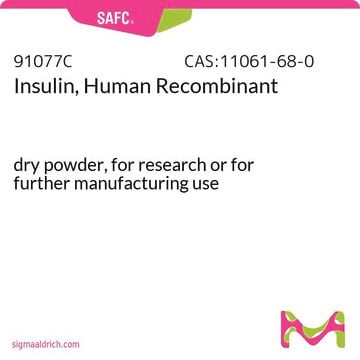Insulin in solution is reasonably stable. Sterile solutions can be stored at 2–8 °C for up to 12 months. Should freezing be preferred, solutions may be stored frozen at -20°C in single-use aliquots. Freeze-thaw cycles should be avoided.
I3536
Insulina
recombinant, expressed in yeast, γ-irradiated, suitable for cell culture
Sinonimo/i:
Insulin human
Scegli un formato
About This Item
Prodotti consigliati
Origine biologica
Saccharomyces cerevisiae
Livello qualitativo
Ricombinante
expressed in yeast
Sterilità
γ-irradiated
Stato
lyophilized powder
Potenza
≥25 USP units per mg
tecniche
cell culture | mammalian: suitable
Solubilità
0.01 M HCl: 20 mg/mL, clear, colorless to faintly yellow
N° accesso UniProt
Condizioni di spedizione
ambient
Temperatura di conservazione
−20°C
InChI
PBGKTOXHQIOBKM-FHFVDXKLSA-N
Informazioni sul gene
human ... INS(3630)
Cerchi prodotti simili? Visita Guida al confronto tra prodotti
Descrizione generale
Applicazioni
Azioni biochim/fisiol
Altre note
Codice della classe di stoccaggio
13 - Non Combustible Solids
Classe di pericolosità dell'acqua (WGK)
WGK 2
Punto d’infiammabilità (°C)
Not applicable
Scegli una delle versioni più recenti:
Certificati d'analisi (COA)
Non trovi la versione di tuo interesse?
Se hai bisogno di una versione specifica, puoi cercare il certificato tramite il numero di lotto.
Possiedi già questo prodotto?
I documenti relativi ai prodotti acquistati recentemente sono disponibili nell’Archivio dei documenti.
I clienti hanno visto anche
-
After reconstitution in 0.01 M HCl, can the aliquot be frozen and for how long?
1 answer-
Helpful?
-
Active Filters
Il team dei nostri ricercatori vanta grande esperienza in tutte le aree della ricerca quali Life Science, scienza dei materiali, sintesi chimica, cromatografia, discipline analitiche, ecc..
Contatta l'Assistenza Tecnica.










